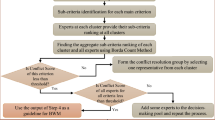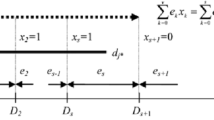Abstract
Decisions on the location and size of medical departments in a given hospital network are prime examples of priority setting in health care, which is an issue of growing political importance. As such decisions are regularly characterized by multiple and often conflicting objectives in real-life, this paper integrates the fields of hospital planning and multiobjective decision support. The proposed two-phase solution procedure for our corresponding mathematical programming model does not require a priori preference information. Instead, it seeks efficient solutions by means of multiobjective tabu search in the first phase, while applying clustering in the second phase to allow the decision makers to interactively explore the solution space until the “best” configuration is determined. The real-world applicability of our approach is illustrated through a numerical example based on hospital data from Germany.
Similar content being viewed by others
References
O.S. Lian, Convergence or divergence? Reforming primary care in Norway and Britain, The Milbank Quarterly 81 (2003) 305–330.
Federal Statistical Office Germany, http://www.destatis.de, accessed May 2002.
K. Levit, C. Smith, C. Cowan, H. Lazenby and A. Martin, Inflation spurs health spending in 2000, Health Affairs 21 (2002) 172–181.
K.R. Levit, H.C. Lazenby, B.R. Braden, C.A. Cowan, P.A. McDonnell, L. Sivarajan, J.M. Stiller, D.K. Won, C.S. Donham, A.M. Long and M.W. Stewart, National health expenditures 1995, Health Care Financing Review 18 (1996) 175–214.
S.B. Schweikhart and V.L. Smith-Daniels, Location and service mix decisions for a managed health care network, Socio-Economic Planning Sciences27 (1993) 289–302.
B. Japsen, Another record year for dealmaking, Modern Healthcare 1996 (26) 37.
W. Lynk, The creation of economic efficiencies in hospital mergers, Journal of Health Economics 14 (1995) 507–530.
L. Berghmans, P. Schoovaerts and J. Teghem, Implementation of health facilities in a new city, Journal of the Operational Research Society 35 (1984) 1947–1054.
C.C. Branas, E.J. MacKenzie and C.S. ReVelle, A trauma resource allocation model for ambulances and hospitals, Health Services Research 35 (2000) 489–507.
S. Chu and L. Chu, A modeling framework for hospital location and service allocation, International Transactions in Operational Research 7 (2000) 539–568.
J. Doherty, L. Rispel and N. Webb, Developing a plan for primary health care facilities in Soweto, South Africa: Applying locational criteria, Health Policy and Planning 11 (1996) 394–405.
R.D. Galvao, L.G.A. Espejo and B. Boffey, A hierarchical model for the location of perinatal facilities in the municipality of Rio de Janeiro, European Journal of Operational Research 138 (2002) 495–517.
A. Green, B. Ali, A. Naeem and D. Ross, Resource allocation and budgetary mechanisms for decentralized health systems: Experiences from Balochistan, Pakistan, Bulletin of the World Health Organization 78 (2000) 1024–1035.
T. Hindle and C. Ngwube, The relative accessibility for health districts to regionally supplied specialist services, Health Services Research 3 (1990) 16–21.
V. Marianov and P. Taborga, Optimal location of public health centres which provide free and paid services, Journal of the Operational Research Society 52 (2001) 391–400.
L. Mayhew, Urban Hospital Location (George Allen & Unwin, London, 1986).
A. Mehrez, Z. Sinuany-Stern, T. Arad-Geva and S. Binyamin, On the implementation of quantitative facility location models: The case of a hospital in a rural region, Journal of the Operational Research Society 47 (1996) 612–625.
R.S. Segall, Deterministic mathematical modelling for the spatial allocation of multi-categorical resources: With an application to real health data, Journal of the Operational Research Society 43 (1992) 579–589.
V.L. Smith-Daniels, S.B. Schweikhart and D.E. Smith-Daniels, Capacity management in health care services: Review and future directions, Decision Sciences 19 (1988) 889–919.
G. Higgs and M.I. Gould, Is there a role for GIS in the 'new NHS'? Health and Place 7 (2001) 247–259.
S. Kohli, K. Sahlen, A. Sivertun, O. Löfman, E. Trell and O. Wigertz, Distance from the primary health center: A GIS method to study geographical access to health care, Journal of Medical Systems 19 (1995) 425–436.
D. Love and P. Lindquist, The geographical accessibility of hospitals to the aged: A geographic information system analysis with Illinois, Health Services Research 29 (1995) 629–650.
W.J.Walsh, P.H. Page and W.M. Gesler, Normative models and healthcare planning: Network-based simulations within a geographic information system environment, Health Services Research 32 (1997) 243–258.
M.A. McGuirk and F.W. Porell, Spatial patterns of hospital utilization: The impact of distance and time, Inquiry 21 (1984) 84–95.
G.W. Shannon, R.L. Bashshur and C.A. Metzner, The concept of distance as a factor in accessibility and utilization of health care, Medical Care Review 26 (1969) 143–161.
S. Rahman and D.K. Smith, Use of location-allocation models in health service development planning in developing nations, European Journal of Operational Research 123 (2000) 437–452.
R. Jantzen and P.R. Loubeau, Hospital selection by managed care insurers, Health Care Management Review 25 (2000) 93–102.
E. Erkut and S. Neuman, Analytical models for locating undesirable facilities, European Journal of Operational Research 40 (1989) 275–291.
A.J. Keown and J.D. Martin, An integer goal programming model for capital budgeting in hospitals, Financial Management 5 (1976) 28–35.
A.K. Rifai and J.O. Pecenka, An application of goal programming in healthcare planning, International Journal of Production Management 10 (1989) 28–37.
M. Ehrgott and X. Gandibleux, A survey and annotated bibliography of multiobjective combinatorial optimization, OR Spektrum 22 (2000) 425–460.
H.S. Brown, Income, location, and the demand for health care from public, nonprofit, and for-profit hospitals, Journal of Health Care Finance 27 (2001) 24–38.
S.M. Goldstein, P.T. Ward, G.K. Leong and T.W. Butler, The effect of location, strategy, and operations technology on hospital performance, Journal of Operations Management 20 (2002) 63–75.
R.S. Segall, Some quantitative methods for determining capacities and locations of military emergency medical facilities, Applied Mathematical Modelling 24 (2000) 265–398.
M.A. Cohen and H.L. Lee, The determinants of spatial distribution of hospital utilization in a region, Medical Care 23 (1985) 27–38.
E.R. de Winter, Are we ignoring population density in health planning? The issues of availability and accessibility, Health Policy and Planning 7 (1992) 191–196.
G.W. Shannon and J.L.Skinner, Time and distance:The journey for medical care, International Journal of Health Services 3 (1973) 237–244.
E.K. Adams, R. Houchens, G.E. Wright and J. Robbins, Predicting hospital choice for rural Medicare beneficiaries: The role of severity of illness, Health Services Research 7 (1991) 583–612.
D. Parkin and J. Henderson, How important is equality of access to hospital? A case study of patients' and visitors' travel costs, Hospital and Health Services Review 83 (1987) 23–27.
N.R. Patel, Locating rural social service centers in India, Management Science 25 (1979) 22–30.
C. Toregas, R. Swain, C. ReVelle and L. Bergman, The location of emergency service facilities, Operations Reserach 19 (1971) 1363–1373.
J.B. Parr, Health care facility planning: Some developmental considerations, Socio-Economic Planning Sciences 13 (1979) 121–127.
D. Martin and H.C. Williams, Market area analysis and accessibility to primary health care centres, Environment and Planning 24 (1992) 1009–1019.
L.A. Aday and R.M. Andersen, A framework for the study of access to medical care, Health Services Research 9 (1974) 208–220.
R.M. Anderson, A. McCutcheon, L.A. Aday, G.Y. Chiu and R. Bell, Exploring dimensions of access to medical care, Health Services Research 18 (1983) 49–74.
R. Keeney and H. Raiffa, Decisions with Multiple Objectives: Preferences and Value Trade-Offs (Wiley, New York, 1976).
D.F. Jones, S.K. Mirrazavi and M. Tamiz, Multi-objective metaheuristics: An overview of the current state-of-the-art, European Journal of Operational Research 137 (2002) 1–9.
C. Coello, An updated survey of GA-based multiobjective optimization techniques, ACM Computing Surveys 32 (2000) 109–143.
P. Czyzak and A. Jaszkiewicz, Pareto Simulated Annealing: A metaheuristic technique for multiple-objective combinatorial optimization, Journal of Multi-Criteria Decision Analysis 7 (1998) 34–47.
X. Gandibleux, N. Mezdaoui and A. Freville, A tabu search procedure to solve multiobjective combinatorial optimization problems, in: Advances in Multiple Objective and Goal Programming, Essays and Surveys on Multiple Criteria Decision Making, eds. F. Ruiz and R. Steuer (Springer, Berlin, 1997).
F. Glover, Tabu search: Part I, ORSA Journal on Computing 1 (1989) 190–206.
F. Glover, Tabu search: Part II, ORSA Journal on Computing 2 (1990) 4–32.
J. Skorin-Kapov, Tabu search applied to the quadratic assignment problem, ORSA Journal on Computing 2 (1990) 33–45.
A. Oddi and A. Cesta, Toward interactive scheduling systems for managing medical resources, Artificial Intelligence in Medicine 20 (2000) 113–138.
M.P. Hansen, Tabu search for multiobjective combinatorial optimization: TAMOCO, Control and Cybernetics 29 (2000) 799–818.
M. Sun and R. Steuer, InterQuad: An interactive quad tree based procedure for solving the discrete alternative multiple criteria problem, European Journal of Operational Research 89 (1996) 462–472.
R. Steuer and F. Harris, Intra-set point generation and filtering in decision and criterion space, Computers and Operations Research 7 (1980) 41–53.
J. Morse, Reducing the size of the nondominated set: Pruning by clustering, Computers and Operations Research 7 (1980) 55–56.
B.S. Everitt, Cluster Analysis, 3rd ed. (Arnold, London, 1993).
A. Hardy, On the number of clusters, Computational Statistics and Data Analysis 23 (1996) 83–96.
G.A. Miller, The magical number seven, plus or minus two: Some limits on our capacity for processing information, Psychological Review 63 (1956) 81–97.
J.D. Jobson, Applied Multivariate Data Analysis: Categorical and Multivariate Methods (Springer, New York, 1992).
H.C. Romesburg, Cluster Analysis for Researchers (Krieger, Malabar, 1984).
R.E. Steuer, Multiple Criteria Optimization: Theory, Computation, and Application (Wiley, New York, 1986).
R.M. Davies, An interactive simulation in the health service, Journal of the Operational Research Society 36 (1987) 597–606.
G.M. Erickson and S.A. Finkler, Determinants of market share for a hospital's services, Medical Care 23 (1985) 1003–1018.
J. Morrisey, Top 100 hospitals set new success standards, Modern Healthcare 24 (1994) 74–76.
R. Stock, Distance and utilization of health facilities in Nigeria, Social Science and Medicine 17 (1983) 563–570.
Author information
Authors and Affiliations
Corresponding author
Rights and permissions
About this article
Cite this article
Stummer, C., Doerner, K., Focke, A. et al. Determining Location and Size of Medical Departments in a Hospital Network: A Multiobjective Decision Support Approach. Health Care Management Science 7, 63–71 (2004). https://doi.org/10.1023/B:HCMS.0000005399.23600.69
Issue Date:
DOI: https://doi.org/10.1023/B:HCMS.0000005399.23600.69




